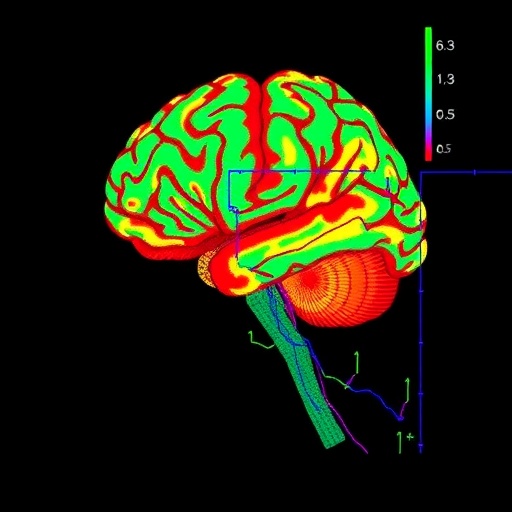
In a groundbreaking advancement that promises to transform our understanding of the primate brain, a team of neuroscientists have developed a novel technique enabling large-scale, high-density neural recordings across the entire brain of nonhuman primates. This pioneering work, recently published in Nature Neuroscience, represents a monumental leap in neural recording technology, pushing the boundaries of what was previously achievable in awake, behaving primates. By combining cutting-edge microelectrode arrays with innovative data acquisition and processing frameworks, this approach is poised to unlock new insights into the complex neural dynamics underpinning cognition, perception, and behavior.
Historically, neuroscientific investigation into primate brain activity has faced significant technical limitations. While single-neuron recordings and low-density arrays have provided invaluable data about localized brain regions, the intricate interplay across widespread neural networks remained largely inaccessible. The challenge has been to record simultaneously from tens of thousands—if not hundreds of thousands—of neurons distributed across anatomically disparate brain areas, without compromising spatial resolution, signal fidelity, or animal welfare during naturalistic behavior. This study overcomes many of these longstanding hurdles.
Central to this breakthrough is the deployment of ultra-high-density multichannel microelectrode arrays, engineered to interface with multiple cortical and subcortical structures concurrently. These arrays incorporate novel biocompatible materials, allowing for chronic implantation with minimal inflammatory response. Their exceptional electrode count—an order of magnitude greater than traditional probes—enables unprecedented spatial sampling across brain-wide circuits. Moreover, the system achieves remarkable temporal resolution, capturing neural spiking and local field potentials with millisecond precision.
.adsslot_MWdcA8Y5fy{ width:728px !important; height:90px !important; }
@media (max-width:1199px) { .adsslot_MWdcA8Y5fy{ width:468px !important; height:60px !important; } }
@media (max-width:767px) { .adsslot_MWdcA8Y5fy{ width:320px !important; height:50px !important; } }
ADVERTISEMENT
The methodology integrates a distributed neural interface architecture, connecting arrays implanted in distinct brain regions to a centralized high-throughput data acquisition platform. This architecture is designed to handle staggering data rates, employing real-time compression algorithms and synchronized time-stamping to maintain data integrity. Such engineering feats are critical, as neural data streams from thousands of channels can easily reach terabytes per recording session. By implementing hardware and software optimizations, the researchers ensured that large-scale recordings are both sustainable and scalable.
Beyond the technical achievements, the neuroscientists conducted extensive validation experiments in awake, behaving nonhuman primates, demonstrating the system’s robustness in naturalistic cognitive tasks. The animals engaged in complex decision-making paradigms while neural activity was simultaneously monitored across multiple cortical areas—including prefrontal, parietal, and sensory cortices—as well as key subcortical nuclei. This simultaneous brain-wide monitoring revealed previously unobserved patterns of coordinated population activity and dynamic information flow, suggesting new mechanisms of distributed neural computation.
Critically, the researchers employed advanced computational analyses, including dimensionality reduction and network modeling, to interpret the massive datasets acquired. By leveraging machine learning and statistical frameworks, they decoded how ensembles of neurons from different regions contribute to specific behavioral states and stimulus representations. This approach sheds light on the mesoscale architecture of neural computation, bridging the gap between single-neuron electrophysiology and systems-level brain function.
The implications of this work extend far beyond basic neuroscience. The ability to record comprehensively and chronically from the primate brain opens avenues for developing more effective brain-machine interfaces (BMIs) with enhanced control fidelity and adaptability. Such interfaces hold promise for restoring motor or sensory functions in patients with neurological impairments. Additionally, this technology could elucidate neural circuit dysfunctions underlying neuropsychiatric disorders where network-wide connectivity alterations play a role, potentially guiding targeted therapeutic interventions.
Importantly, this system balances high-density recording capabilities with animal safety and comfort. By minimizing tissue damage through optimized electrode design and surgical implantation procedures, and by incorporating biocompatible materials, the researchers have set a new standard for ethical chronic neural interfacing. This ensures that insights gained will be grounded in behaviorally relevant conditions, enabling longitudinal studies of brain plasticity and cognitive development.
From a technical standpoint, the study describes innovations in microfabrication techniques used to produce the electrode arrays. Utilizing advanced lithography and material deposition methods, the team achieved precise electrode spacing and flexible substrates capable of conforming to brain surfaces and penetrating target regions. Customized connectors and modular interface boards facilitate expansion and adaptability across different experimental configurations.
The data management pipeline represents another critical innovation. By integrating custom-designed integrated circuits for signal amplification and digitization directly on the probe, noise is reduced, and signal quality is improved. The centralized data hub orchestrates synchronized multi-site recordings, aided by fiber-optic communications to minimize electromagnetic interference. This architecture supports parallel processing and scalable storage solutions, an essential consideration given the volume of neural data generated.
Behavioral task design was carefully aligned with recording capabilities. The animals performed sensorimotor integration tasks requiring rapid decision-making and attentional shifts, allowing researchers to probe neural correlates of executive function and sensory processing simultaneously. This integrative approach unveils how diverse neural populations collaborate in real-time to orchestrate complex behaviors, a step toward a holistic understanding of brain function.
The results demonstrate remarkable spatiotemporal complexity in neural activity patterns spanning the brain. Cross-regional synchrony fluctuated dynamically with task demands, and neural population codes shifted adaptively as animals learned or adjusted strategies. These observations challenge traditional hierarchical models of brain processing, suggesting instead highly interactive, distributed networks operate in parallel. Such insights may redefine prevailing theories of cognition and neural computation.
Future directions highlighted by the authors include scaling this technology to even greater coverage and resolution, coupled with closed-loop modulation techniques. Incorporating optogenetic or pharmacological interventions in tandem with large-scale recordings could enable causal testing of hypotheses about neural circuits. Moreover, integrating this platform with advanced imaging modalities offers the potential to correlate electrophysiological signals with cellular and molecular brain states.
This landmark achievement heralds a new era in primate neuroscience, where comprehensive, multiscale monitoring of brain activity is no longer an aspiration but a reality. By providing an unparalleled window into the living brain’s intricate operations during naturalistic behaviors, this technology opens exciting frontiers for understanding the neural foundations of intelligence, perception, and consciousness itself. As researchers worldwide adopt and build upon these tools, the coming years promise profound discoveries with implications ranging from medicine to artificial intelligence.
In conclusion, the large-scale high-density brain-wide neural recording system elucidated by Trautmann, Hesse, Stine, and colleagues stands as a testament to the synergistic power of multidisciplinary innovation. Marrying materials science, engineering, computational neuroscience, and primate biology, this work transcends existing limitations and sets an inspiring precedent. It is a pivotal step toward decoding the brain’s mysteries at an unprecedented scale, offering hope for transformative applications in health and technology.
Subject of Research: Large-scale, high-density neural recording technology in nonhuman primates enabling brain-wide simultaneous monitoring of neuronal populations.
Article Title: Large-scale high-density brain-wide neural recording in nonhuman primates.
Article References:
Trautmann, E.M., Hesse, J.K., Stine, G.M. et al. Large-scale high-density brain-wide neural recording in nonhuman primates. Nat Neurosci (2025). https://doi.org/10.1038/s41593-025-01976-5
Image Credits: AI Generated
Tags: advancements in neurotechnologyawake behaving primateschronic brain recording techniqueshigh-density neural recordingsinnovative neuroscience methodologieslarge-scale neural data acquisitionmicroelectrode array technologymultichannel neural interfacesneural dynamics and cognitionprimate brain researchprimate neural networksspatial resolution in neuroscience



